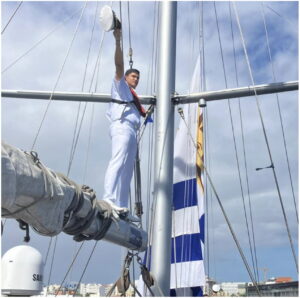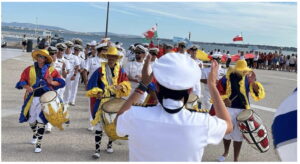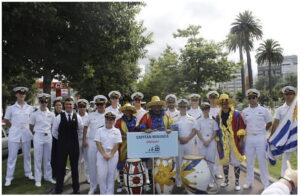From Falmouth to Montevideo: A Voyage on Uruguayan Navy Tall Ship Capitán Miranda

Our correspondent draws lessons from his time sailing with the Uruguayan Navy aboard the schooner Capitán Miranda, with a Joint mission of training future officers in seamanship and conducting naval diplomacy around the globe. A 10 minute read.
In August 2023 I joined the Uruguayan Navy’s sail training ship Capitán Miranda little over halfway through her epic seven-month deployment. Since departing the shallow waters of the River Plate, her 80-strong ship’s company had already experienced the delights of New York, a stormy North Atlantic crossing and the busy schedule of the 2023 Tall Ship Races around northern Europe.
Her aim was twofold. First, was to fly the flag and a rather large one it was too! Usually confined to the local waters of the South Atlantic, the opportunity for a Uruguayan Navy (hereafter URN) vessel to visit a string of European ports was a rare chance to rekindle relations with international friends and partners. Second, was taking 24 young officers fresh from the Naval Academy and introducing them to leadership and responsibility at sea.
Embarking for the final two months of the deployment as she turned homeward bound to Montevideo, I was minded of my rather poor linguistic skills, and as the only foreigner onboard (apart from a brief handover with my opposite number who had been onboard for the two months previous), I had little idea what to expect or what would be expected of me.
Despite my questionable aptitude for languages the whole ships company quickly made me feel one of their own. By the end of my time onboard not only had I grown an appreciation of another navy, but also an understanding of the national culture driving it. The following reflects upon three areas of difference I observed between the URN and the RN and argues that these might present a valuable opportunity to learn from another nation.
Sail training and young officers
Capitán Miranda is first and foremost a sail training ship. Fulfilling the role since her 1978 conversion from naval survey vessel to triple-masted schooner, she serves as the first assignment for all young officers. This includes officers from all branches be it warfare, logistics, engineering or the ‘Prefectura’, Uruguay’s Coast Guard. Their core responsibilities are split into two functions. One is the primary role relating to their branch. For example, the Midshipmen streamed for marine engineering lead watches in the engine room whilst the young warfare officers take watches on the bridge as the officer of the watch. In both roles, a supervising officer is on call to advise, assist and if needed, take charge, but in the first instance the burden of responsibility falls to the young officers.
Thus far, the picture is similar to phase two officer training in the RN. Like their Uruguayan counterparts, RN junior warfare officers also build watchkeeping experience on the Bridge as the Second Officer of the Watch whilst young marine engineers complete their Assistant Marine Engineer Officer time in their equivalent environment. However, there is a divergence that becomes clearer when considering the Uruguayan young officers’ involvement in the running of the 60 metres of deck from which she is sailed.
When under sail, especially during the offshore legs of the Tall Ship Races, the Midshipmen are distributed among the vessel’s three masts to assist in managing the labour-intensive sailing evolutions. Despite Miranda’s Bermudan rig making a lack of rigging to climb and yard arms to straddle, each manoeuvre demands considerable effort. For every tack or gybe the off-watch would be stood-to to execute the evolution. This means the young officers are continually placed in positions of leadership where they must manage relatively large numbers of people to complete physically demanding tasks in a safe but dynamic manner.
This is where the difference in training cultures becomes evident. Whereas most RN young officers complete six weeks Initial Sea Time as a cadet, then four months Common Fleet Time as a Midshipman, and finally further fleet training as a Sub-Lieutenant before being placed in positions of real responsibility and leadership, the URN does it differently. They gain responsibility immediately, using sail training as the means of delivery.[1]
There are clear advantages of this approach. Crucially, it allows young officers to experience the burden of responsibility earlier. Modern warships’ internal complexity matched against their high tempo of operations, make the task of exposing young officers to genuine positions of leadership a challenging one. Meanwhile, the URN overcomes this hurdle by introducing Midshipmen to leadership roles in a setting where they must make quick but coordinated decisions and lead teams of sailors to achieve immediate goals, but without the added risks accompanying the equivalent situation on a warship. Therefore, maritime-based leadership is nurtured in an operationally benign but fast-moving environment.
In short, whilst such a model does not remove the requirement for young officers to gain whole-ship and specialist knowledge aboard warships, it does offer an alternative approach. It may be an approach worthy of further study and thought. Primarily, this is because it delivers officers to the fleet already well versed in leading and working with sailors in challenging and complex situations – something the current RN system introduces at a much later stage.
Next, the second area of difference I encountered concerns another field altogether – the conduct of naval diplomacy.
Middle ground: A platform for diplomacy
Naval diplomacy is firmly embedded, both physically and conceptually, as a core naval role. Conceptually, as set out in doctrine, it is one of the RN’s three fundamental maritime functions; and physically, via the sheer frequency and scale with which RN ships visit ports across the globe (be it HMS Tamar in the Indo-Pacific or HMS Prince of Wales along the East Coast of the USA).
Yet, the conduct of naval diplomacy is something of a chameleon; adopting different appearances to communicate a wide spectrum of signals to whoever the intended recipient(s) may be. At one end warships are well suited to deliver the more definitive and overt messages to coerce or deter potential adversaries. However, at the other end of the spectrum is the need to communicate less overt and more expressive, benign signals to allies and partners. It is here where a vessel like Capitán Miranda comes into their prime. On the one hand she remains a military vessel with the associated symbolism that accompanies it. But rather than being equipped to threaten, she is optimised to promote partnership and prosperity in line with Uruguay’s interests. In the words of the vessel’s website, she is the nation’s “ambassador to the seas and the world,” hosting dignitaries and diplomats onboard in every port. The outcome is that not only do guests leave with an impression of URN’s intent, but also a broader appreciation for their culture and trade.

A Midshipman of the ‘Prefectura’ waves farewell to crowds in A Coruña, Spain
Nevertheless, it would be misleading to claim that naval diplomacy is a dichotomous activity. Warships can be used for a myriad of diplomatic functions – and are on a routine basis. However, the impression made by a diplomatic event hosted on a warship is very different to one on a tall ship and isn’t without opportunity cost. In an RN fleet where the number of taskings seem ever-growing whilst the numbers of seagoing platforms battle to keep up, deploying a capable warship to deliver effect at the lower end of the spectrum creates something of a trade-off. To an extent a warship can be worked-up to perform both diplomatic and warfighting roles, but there comes a point where the command aim will prioritise one over the other. For a vessel such as Capitán Miranda, it is unnecessary to strike such a balance, as she holds only a contingent wartime role as a medical ship.
This raises the question as to why the UK doesn’t have such a platform: A diplomatic flagship to promote UK foreign policy and trade interests. The UK used to deploy the Royal Yacht HMY Britannia around the globe for such tasks. More recently, then Defence Secretary Ben Wallace under the Johnson government proposed a new National Flagship to “promote UK diplomatic and trading interests in coastal capitals around the world.”[2] Both were scrapped due to deemed unacceptable costs to the taxpayer – and RN budgets.
A naval sail-training ship, with the dual utility of training the next generation of naval leaders and promoting UK trade and diplomacy within a single hull, could be a more attractive option.
During my time on Capitán Miranda, I was met with repeated surprise when I said (against the scattering of naval training ships from other nations in the background) that the RN didn’t have a Tall Ship of its own. The Sea Cadets have the square-rigged T/S Royalist, so why doesn’t the RN have its own equivalent? The Uruguayan model presents an opportunity to fulfil the late Defence Secretary’s ambition but without the political controversy and high cost.
This second area of difference in the conduct of naval diplomacy feeds into the third and final difference I observed – their approach to promoting understanding between both their military services and wider society.
Supporting the moral component
Contributing to the moral component of fighting power are the factors of moral cohesion, motivation and leadership.[3] Underpinning all three is an esprit de corps providing a feeling of common purpose and collective identity, not just confined to the military but extending to the society it serves too. Albeit on a small scale, Capitán Miranda is positioned to achieve this by reaching out to both the military and civil wings of its national society.

Sailors and officers perform the traditional ‘candombe’ drum rhythm during the 2023 Tall Ship Races Crew Parade in Lisbon, Portugal.
This is because in addition to the 24 Midshipmen were four guests joining for the duration of the deployment. One was a junior cavalry officer; another was a young air force pilot whilst the other was a recent graduate from the police academy. Meanwhile, the fourth visitor was a biology student from the national university in Montevideo. Therefore, not only was Capitán Miranda looking outwards to the world, but she was also focussed inwards on the public sphere and developing understanding on an intranational level.
Again, it would be misleading to ignore the fact that exchanges between the Services are common in the UK as well. But the difference with Capitán Miranda is how all of these were brought together in a single place to combine an added layer of national benefit to an otherwise international endeavour.
Introducing a similar set-up on an RN equivalent sail-training vessel would not just be nice to have. Rather, it would contribute to wider Defence Engagement by developing our understanding of partner nations and their cultures. As the joint doctrine publication says itself, to build that understanding requires building links with other militaries, strengthening alliances and using professional competence to promote credibility – something Capitán Miranda achieves with aplomb.
Above all is the challenge of building trust; a quality hard won and based on experience. Nations that trust each other are more likely to operate successfully together. From my experience with Capitán Miranda, I can rest assured that the next time I come across the Uruguayan Navy, I will not just see a partner to work with, but instead a friend that I can trust. If some of that can be converted into a RN sail-training ship, then perhaps a powerful opportunity presents itself indeed.

The officers of Capitán Miranda prior to the Crew Parade in A Coruña, Spain
References
[1] It would be unfair to claim that the RN neglects sail training all together. There is a small fleet of Contessa yachts based at BRNC on the River Dart. However, these are only used by cadets for a couple of days at a time, covering short distances, and lack the developmental opportunities and overall complexity offered on a larger platform.
[2] https://www.gov.uk/government/speeches/defence-secretary-national-flagship-engagement-day-speech
[3] Development, Concepts and Doctrine Centre, ‘Defence Doctrine’, JDP 0-01, 2022, p. 26-28. [online]. Available at: https://assets.publishing.service.gov.uk/media/63776f4de90e0728553b568b/UK_Defence_Doctrine_Ed6.pdf. Accessed: 10/1/24.
